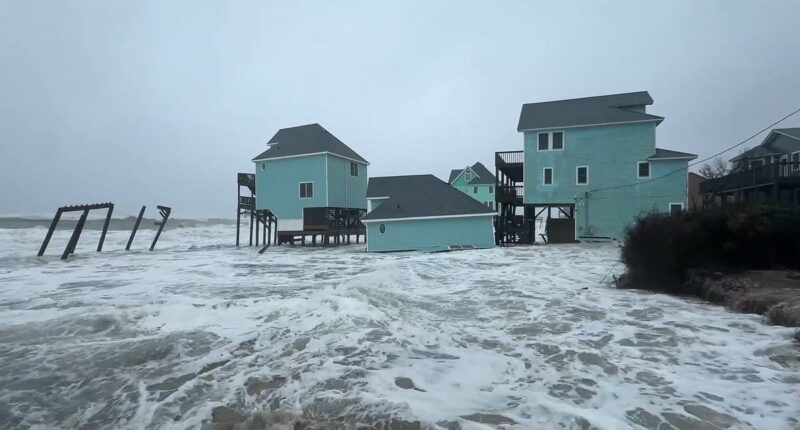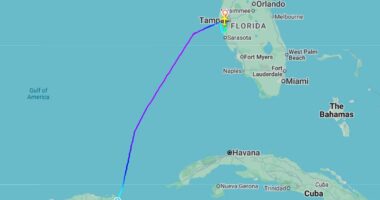Share this @internewscast.com
The relentless advance of the Atlantic Ocean has claimed another four properties along North Carolina’s coast, as the ongoing coastal erosion nightmare continues to unfold.
On Tuesday morning, from 10:45 a.m. to 1:00 p.m., powerful waves generated by a coastal storm obliterated a cluster of elevated turquoise vacation homes near Buxton on the Outer Banks.
According to Accuweather, all the affected properties were unoccupied at the time of the incident.
Dramatic video footage captures the homes’ last moments, with remnants of one house drifting into the sea, leaving only the supporting stilts standing in defiance.
Since 2020, Hatteras Island has witnessed the ocean swallowing 26 homes, with two additional properties intentionally demolished due to imminent environmental threats, as reported by the outlet.
The Outer Banks, a chain of islands that includes Buxton, has faced repeated disasters, most recently when five homes disintegrated within a single hour.
Waves ranging from six feet to 12 feet tore down the properties one by one around 2pm. Luckily, the $400,000 homes were all vacant since being condemned in 2023.
While homes topple down left and right, the coast of North Carolina has been a looming issue for decades.

Devastating waves from a coastal storm demolished a plot of lifted turquoise vacation homes on Tuesday from 10.45am to 1pm near Buxton on the Outer Banks

The properties, which were vacant, were swallowed by the swell of the Atlantic in alarming footage

While homes topple down left and right, the coast of North Carolina has been a looming issue for decades
From 1980 to 2020, the shoreline moved inland by 675 feet, roughly 13.5 feet per year, according to the outlet.
The coastal haven is fragile because of its geography and small size, and because it lacks protection from the ocean, such as sea walls.
The string of islands is so vulnerable that even when Hurricane Joaquin missed the banks in 2015 by 500 miles, it was still damaged by waves and surge from the storm, causing $2.3million in damage.
Climate change does not help by causing sea levels to rise closer to homes on beaches and by creating stronger storms than typically seen.
Highway 12, which runs through the chain of islands, has been a headache for the state to maintain, costing roughly $43million since 2012, but doesn’t include the $145million used to renovate the road farther from the ocean, according to WSOC.
The road is notorious among locals for flooding and being inaccessible.

From 1980 to 2020, the shoreline moved inland by 675 feet, roughly 13.5 feet per year

The coastal haven is fragile because of its geography and small size, and because it lacks protection from the ocean, such as sea walls
On top of the destruction, real estate sales in the area have taken a hit since last August, down by 1 percent according to the Outer Banks Association of Realtors.
However, condominium sales have increased by 5 percent, but land sales have tanked by 12 percent.
The median sales price increased by less than 1percent from $630,000 to $633,250.
The National park Service has taken actions to work with those whose homes have collapsed.
The park service has cleaned up miles of debris and has communicated with owners of structures in risk of falling apart.
The Threatened Oceanfront Structures Interagency Work Group was formed as well which was established in August 2022 to ‘engage with partner organizations and stakeholders to identify, research, and recommend policy and/or program improvements to establish more proactive, comprehensive, and predictable strategies for addressing structures at immediate risk of collapse,’ according to their website.















